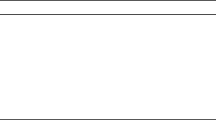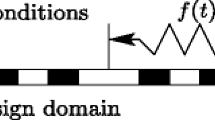Abstract
Automatic Differentiation (AD) is a tool that systematically implements the chain rule of differentiation to obtain the derivatives of functions calculated by computer programs. In this paper, it is assessed as a tool for engineering design. The paper discusses the forward and reverse modes of AD, their computing requirements, as well as approaches to implementing AD. It continues with the application of two different tools to two medium-size structural analysis problems to generate sensitivity information typically necessary in an optimization or design situation. The paper concludes with the observation that AD is to be preferred to finite differencing in most cases, as long as sufficient computer storage is available; in some instances, AD may be the alternative to consider in lieu of analytical sensitivity analysis.
Similar content being viewed by others
References
Barthelemy, J.-F.M.; Hall, L.E. 1992: Automatic differentiation as a tool for engineering design.Proc. 4th AIAA/Air Force/NASA/OAI Symp. on Multidisciplinary Analysis and Optimization (held in Cleveland, OH)
Barthelemy, J.-F.M.; Riley, M.F. 1988: Improved multilevel optimization approach for the design of complex engineering systems.AIAA J. 26, 353–360
Barthelemy, J.-F.M.; Wrenn, G.A.; Dovi, A.R.; Coen, P.G. 1992: Integrating aerodynamics and structures in the minimum weight design of a supersonic transport wing.AIAA Paper 92-2372, presented at 33rd AIAA/ASME/AHS/ASC Structures, Structural Dynamics and Materials Conf. (held in Dallas, TX)
Bathe, K.-J.; Wilson, E.L. 1976:Numerical methods in finite element analysis. New York: Prentice-Hall
Bischof, C.; Carle, A.; Corliss, G.; Griewank, A.; Hovland, P. 1991: ADI-FOR-Generating derivative codes for Fortran programs.Argonne Preprint, MCS-P 263-0991
Bischof, C.; Green, L.; Haigler, K.; Knauff, T. 1994: Parallel calculation of sensitivity dervatives for aircraft design using automatic differentiation.AIAA 94-4261. (5th AIAA/USAF/NASA/ISSMO Symp. on Multidisciplinary Analysis and Optimization, Panama City Beach, FL)
Callahan, D.; Cooper, K.; Hood, R.T.; Kennedy, K.; Torcson, L.M. 1988: ParaScope: a parallel programming environment.Int. J. Supercomputer Applications 2, 273–285
Carle, A.; Green, L.; Bischof, C.; Newman, P. 1994: Applications of automatic differentiation in CFD.AIAA 94-2197. (25th AIAA Fluid Dynamics Conf., Colorado Springs, CO)
Garcia, O. 1991: A system for the differentiation of Fortran codes and an application to parameter estimation in forest growth models. In: Griewank, A.; Corliss, G.F. (eds.)Automatic differentiation of algorithms: theory, implementation, and application, pp. 273–285. Philadelphia: SIAM
Giles, G.L. 1986: Equivalent plate analysis of aircraft wing box structures with general planform geometry.J. Aircraft 23, 859–864
Giles, G.L. 1989: Further generalization of an equivalent plate representation for aircraft structural analysis.J. Aircraft 26, 67–74
Griewank, A. 1991a: The chain rule revisited in scientific computing.SIAM News, p. 20
Griewank, A. 1991b: The chain rule revisited in scientific computing, part II.SIAM News, p. 8
Griewank, A. 1991c: Automatic evaluation of first and higher derivative vectors. In: Schneider; Dupper; Troger (eds.)Analysis, algorithms, applications (Proc. Conf. on Bifurcation and Chaos, held in Wurzburg, 1990), pp. 124–137. Basel: Birkhäuser
Griewank, A. 1992: Achieving logarithmic growth of temporal and spatial complexity in reverse automatic differentiation.Optimization Methods and Software 1, 35–54
Griewank, A.; Corliss, G.F. (eds.) 1991:Automatic differentiation of algorithms: theory, implementation, and application. Philadelphia: SIAM
Griewank, A; Reese, S. 1991: On the calculation of Jacobian matrices by the Markowitz rule. In: Griewank, A.; Corliss, G.F. (eds.)Automatic differentiation of algorithms: theory, implementation, and application, pp. 126–135. Philadelphia: SIAM
Haftka, R.T.; Gurdal, Z. 1992:Elements of structural optimization, 3rd edition. Dordrecht: Kluwer
Haug, E.J.; Arora, J.S. 1979:Applied optimal design. New York: J. Wiley and Sons
Horwedel, J.E. 1991a: GRESS version 2.0 user's manual.Report ORNL/TM-11951
Horwedel, J.E. 1991b: GRESS, a preprocessor for sensitivity analysis of Fortran programs. In: Griewank, A.; Corliss, G.F. (eds.)Automatic differentiation of algorithms: theory, implementation, and application, pp. 243–250. Philadelphia: SIAM
Iri, M. 1984: Simultaneous computation of functions, partial derivatives and estimates of rounding errors — complexity and practicality.Japan J. Appl. Math. 1, 223–252
Iri, M. 1988: Automatic computation of partial derivatives and rounding error estimates with applications to large-scale systems of nonlinear equations.J. Comp. Appl. Math. 24, 365–392
Iri, M. 1991: History of automatic differentiation and rounding error estimation. In: Griewank, A.; Corliss, G.F. (eds.)Automatic differentiation of algorithms: theory, implementation, and application, pp. 3–16. Philadelphia: SIAM
Juedes, D.W. 1991: A taxonomy of automatic differentiation tools. In: Griewank, A.; Corliss, G.F. (eds.) Automatic differentiation of algorithms: theory, implementation, and application, pp. 315–329. Philadelphia: SIAM
Rall, L.B. 1981:Automatic differentiation: techniques and applications. Lecture Notes in Computer Science No. 120. Berlin, Heidelberg, New York: Springer
Talagrand, O. 1991: The use of adjoint equations in numerical modeling of the atmospheric circulation. In: Griewank, A.; Corliss, G.F. (eds.) Automatic differentiation of algorithms: theory, implementation, and application, pp. 169–180. Philadelphia: SIAM
Thacker, W.M. 1991: Automatic differentiation from an oceanographer's perspective. In: Griewank, A.; Corliss, G.F. (eds.) Automatic differentiation of algorithms: theory, implementation, and application, pp. 191–201. Philadelphia: SIAM
Worley, B.A. 1991: Experience with the forward and reverse mode of GRESS in contaminant transport modeling and other applications. In: Griewank, A.; Corliss, G.F. (eds.) Automatic differentiation of algorithms: theory, implementation, and application, pp. 307–314. Philadelphia: SIAM
Author information
Authors and Affiliations
Additional information
Communicated by J. Sobieski
Rights and permissions
About this article
Cite this article
Barthelemy, J.F.M., Hall, L.E. Automatic differentiation as a tool in engineering design. Structural Optimization 9, 76–82 (1995). https://doi.org/10.1007/BF01758823
Received:
Issue Date:
DOI: https://doi.org/10.1007/BF01758823




